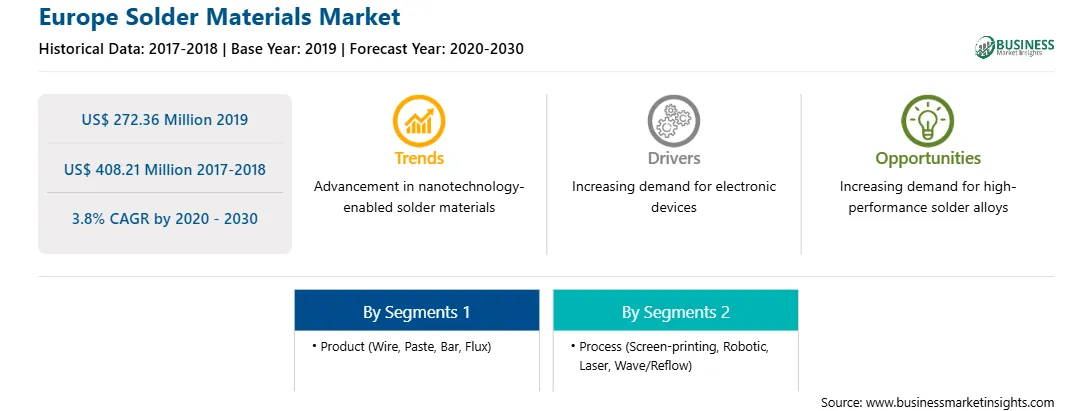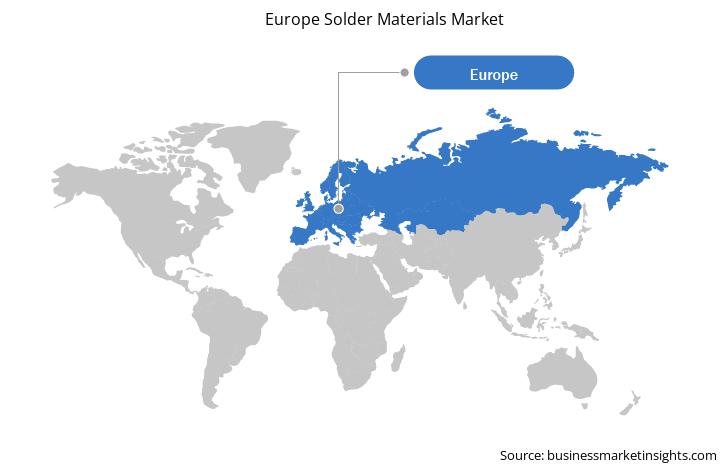European continent comprises of several developing economies such as Germany, France, UK, and Italy, among others. The western part of Europe is known for its better standards of living, with people displaying a higher income level. It is one of the wealthiest regions on the European continent, with per capita Gross Domestic Product (GDP) more than the other parts. The European consumer displays variations in preferences and reflects economic status and consumption habits of different countries. Europe is a well-established and mature market for solder materials. Overall, European legislation mainly focuses on environmental and security issues that have favored the demand for intelligent and efficient products and solutions. A number of European Union (EU) Directives in the last few years has accelerated the development of electronic vehicles and electronic lighting in Europe. Thus, an increasing demand from the electronics industry is anticipated to create a drive for Europe solder materials market in the coming years.
Strategic insights for the Europe Solder Materials provides data-driven analysis of the industry landscape, including current trends, key players, and regional nuances. These insights offer actionable recommendations, enabling readers to differentiate themselves from competitors by identifying untapped segments or developing unique value propositions. Leveraging data analytics, these insights help industry players anticipate the market shifts, whether investors, manufacturers, or other stakeholders. A future-oriented perspective is essential, helping stakeholders anticipate market shifts and position themselves for long-term success in this dynamic region. Ultimately, effective strategic insights empower readers to make informed decisions that drive profitability and achieve their business objectives within the market.

| Report Attribute | Details |
|---|---|
| Market size in 2019 | US$ 272.36 Million |
| Market Size by 2030 | US$ 408.21 Million |
| Global CAGR (2020 - 2030) | 3.8% |
| Historical Data | 2017-2018 |
| Forecast period | 2020-2030 |
| Segments Covered |
By Product
|
| Regions and Countries Covered | Europe
|
| Market leaders and key company profiles |
The geographic scope of the Europe Solder Materials refers to the specific areas in which a business operates and competes. Understanding local distinctions, such as diverse consumer preferences (e.g., demand for specific plug types or battery backup durations), varying economic conditions, and regulatory environments, is crucial for tailoring strategies to specific markets. Businesses can expand their reach by identifying underserved areas or adapting their offerings to meet local demands. A clear market focus allows for more effective resource allocation, targeted marketing campaigns, and better positioning against local competitors, ultimately driving growth in those targeted areas.

The solder materials market in Europe is expected to grow from US$ 272.36 Mn in 2019 to US$ 408.21 Mn by 2030; it is estimated to grow at a CAGR of 3.8% from 2020 to 2030. Solder is basically a fusible metal alloy utilized to create a permanent bond between metal work pieces. Solder is melted in order to adhere to as well as connect the pieces together after cooling, which further requires that an alloy suitable for use as solder with a lower melting point than the pieces being joined. Over the years, an increase in spending toward R&D activities related to solder materials has been initiated by several research institutions, centers, and industries. Further, research on such materials is gaining momentum, which is attributable to their properties, such as toughness along with ductility, better strength, and high electrical conductivity, making them ideal for diversified industrial applications. The market for solder materials embarks numerous opportunities, and, therefore, manufacturers are continuously looking forward to aligning the use of these materials with different application bases. These continuous R&D initiatives is bolstering the growth of the Europe solder materials market.
In terms of product, the wire segment accounted for the largest share of the Europe solder materials market in 2019. In terms of process, the wave/reflow segment held a larger market share of Europe solder materials market in 2019.
A few major primary and secondary sources referred to for preparing this report on the Europe solder materials market are company websites, annual reports, financial reports, national government documents, and statistical database, among others. Major companies listed in the report are Fusion Incorporated, Indium Corporation, Kester, KOKI Company Ltd., Lucas-Mihaupt Inc., Qualitek International Inc., Senju Metal Industry Co., Ltd., Stannol GmbH and Co. KG, Tamura Corporation, and Nihon Genma.
The List of Companies - Europe Solder Materials Market
The Europe Solder Materials Market is valued at US$ 272.36 Million in 2019, it is projected to reach US$ 408.21 Million by 2030.
As per our report Europe Solder Materials Market, the market size is valued at US$ 272.36 Million in 2019, projecting it to reach US$ 408.21 Million by 2030. This translates to a CAGR of approximately 3.8% during the forecast period.
The Europe Solder Materials Market report typically cover these key segments-
The historic period, base year, and forecast period can vary slightly depending on the specific market research report. However, for the Europe Solder Materials Market report:
The Europe Solder Materials Market is populated by several key players, each contributing to its growth and innovation. Some of the major players include:
The Europe Solder Materials Market report is valuable for diverse stakeholders, including:
Essentially, anyone involved in or considering involvement in the Europe Solder Materials Market value chain can benefit from the information contained in a comprehensive market report.